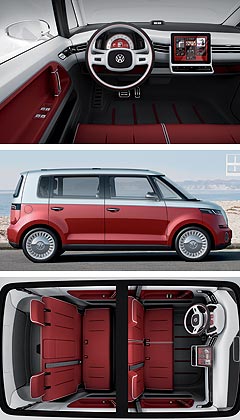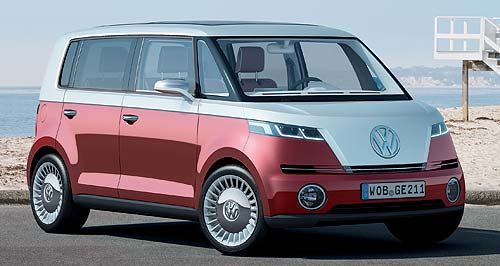Make / Model Search
Future models - Volkswagen - BulliGeneva show: VW resurrects Kombi – againBulli: Volkswagen reveals a new Kombi concept at Geneva. Another born-again VW Kombi emerges, this time a chance of becoming reality1 Mar 2011 VOLKSWAGEN has again raised hopes of a new-generation Kombi reaching production by revealing an all-new van concept in the spirit of its 1950 original ahead of its global debut at this week’s Geneva motor show. Judging by the press release that accompanied pictures of the German giant’s newest Kombi concept, however, the new Bulli show car appears to have a greater chance of hitting showrooms than the still-born Microbus concept from a decade ago at the 2001 Detroit motor show. “In this vehicle, Volkswagen is finishing what it started in 2001,” said the company. “Ten years ago, the vision of a new Bulli led to an unforgettable concept vehicle known as the Microbus, but some visions need to mature before they yield something new. “Now, the time is right for this vision. That is because the concept was sharpened and the necessary, sustainable technologies are now at hand. “This concept has the potential to establish a new, fifth brand of people carrier next to the Caddy, Touran, Sharan and its large counterpart – the Caravelle.” Naturally, the Bulli concept – which takes its name from the German name for the original Kombi (which in turn was called the Microbus in North America) – is far ‘greener’ than the 2001 Detroit concept that used a then-new 170kW/320Nm 3.2-litre petrol V6 sourced from the Golf R32 and Phaeton limousine to power its front wheels.  Instead of that configuration – or the original Kombi’s Beetle-style rear-drive/rear-engine layout – the zero-emissions Bulli arrives with all-electric drive, via a front-mounted 85kW/270Nm motor that powers the front wheels. Instead of that configuration – or the original Kombi’s Beetle-style rear-drive/rear-engine layout – the zero-emissions Bulli arrives with all-electric drive, via a front-mounted 85kW/270Nm motor that powers the front wheels.VW said the set-up delivers up to 300km on a single charge of the Bulli’s 40kWh lithium-ion battery, which is claimed to fully recharge in less than an hour. Zero to 100km/h acceleration is similar to the original Kombi at 11.5 seconds, as is the Bulli’s (electronically limited) top speed of 140km/h. Like the T5 Transporter-based Microbus concept, which had been expected to replace the Caravelle around the world – including in Australia – by 2004, VW says the Bulli could also be motivated by diesel power, as well as with turbocharged petrol engines displacing between 1.0 and 1.4 litres. The six-seater Bulli is more compact than the Californian-designed Microbus concept – which measured 4722mm long, 1909mm wide and 1904mm high and rode on a 3000mm wheelbase – as well as shorter and lower but wider than the original T1-codenamed (for Transporter 1) Kombi. The 1450kg Bulli measures 3990mm long, 1750mm wide and 1700mm tall, and rides on a 2620mm wheelbase and wide 1500mm tracks for the 18-inch alloy wheels. The earlier Microbus concept featured then-cutting-edge technologies such as Xenon headlights, electronic sliding doors, a semi-transparent floor, joystick-style gearshifter, reversing camera and a highly adjustable three-row seat design including a 180-degree rotatable second row and four large screens in the backrests of the first and second rows. Of course, the Bulli goes further by offering an infotainment system controlled via iPad, narrow dual headlights with L-shaped LED daytime running lights and turn indicators, and large round foglights either side of a central air intake. Although the Bulli looks almost identical to the Microbus at a quick glance, a closer inspection reveals it lacks the sliding rear door and D-pillar air-vents of its 1950 and 2001 predecessors, instead offering four conventional front-hinged doors. Styled by a team led by Volkswagen Group Design boss Walter de Silva and Volkswagen brand design chief Klaus Bischoff, the Bulli also reintroduces the original Kombi and Beetle’s large frontal V-shape with oversized white VW badging. Inside, VW claims 370 litres of luggage space behind the rear seats and a full 1600 litres with them folded, while an obligatory panoramic glass roof resides above all six occupants. However, seats are arranged not in three rows of two but in two rows of three, with a full-width front bench seat supplemented by a rear seat that also accommodates three passengers on a fully flat floor. The rear seats can be removed and the 60/40-split front seat can be fully reclined, transforming the Bulli into a campervan, albeit one that’s slightly more compact than the Kombi. Bringing the Bulli well and truly into the 21st Century is a removable iPad in the centre console, which serves as a multi-function touch-screen to operate internet-based iPad applications, climate controls, Bluetooth hands-free telephone and a navigation system, and a sound system designed by legendary US guitar and amplifier manufacturer Fender. While a large semi-circular speedo dominates the Bulli’s instrument panel and a row of lateral air-vents runs across the dashboard, there is no tacho or gear position indicator in the Bulli, which instead features a rotary switch to the right of the driver to activate forward and reverse gears.  Read moreAll future models Alfa Romeo Alfa Romeo Abarth Abarth Alpine Alpine Alpina Alpina Audi Audi Aston Martin Aston Martin BMW BMW Bentley Bentley Chery Chery Brabham Brabham Chrysler Chrysler Chevrolet Chevrolet Cupra Cupra Citroen Citroen DS DS Dodge Dodge Fiat Fiat Ferrari Ferrari Foton Foton Ford Ford Great Wall Great Wall FPV FPV Haval Haval GWM GWM Honda Honda Holden Holden Hummer Hummer HSV HSV Infiniti Infiniti Hyundai Hyundai Jaguar Jaguar Isuzu Isuzu Kia Kia Jeep Jeep Land Rover Land Rover Lamborghini Lamborghini Lexus Lexus LDV LDV Mahindra Mahindra Lotus Lotus Mazda Mazda Maserati Maserati Mercedes-AMG Mercedes-AMG McLaren McLaren MG MG Mercedes-Benz Mercedes-Benz Mitsubishi Mitsubishi Mini Mini Opel Opel Nissan Nissan Peugeot Peugeot Pagani Pagani Proton Proton Porsche Porsche Renault Renault Ram Ram Rover Rover Rolls-Royce Rolls-Royce Skoda Skoda Saab Saab SsangYong SsangYong Smart Smart Suzuki Suzuki Subaru Subaru Toyota Toyota Tesla Tesla Volvo VolvoMotor industry news |
Click to shareVolkswagen modelsResearch Volkswagen All future models Alfa Romeo Alfa Romeo Abarth Abarth Alpine Alpine Alpina Alpina Audi Audi Aston Martin Aston Martin BMW BMW Bentley Bentley Chery Chery Brabham Brabham Chrysler Chrysler Chevrolet Chevrolet Cupra Cupra Citroen Citroen DS DS Dodge Dodge Fiat Fiat Ferrari Ferrari Foton Foton Ford Ford Great Wall Great Wall FPV FPV Haval Haval GWM GWM Honda Honda Holden Holden Hummer Hummer HSV HSV Infiniti Infiniti Hyundai Hyundai Jaguar Jaguar Isuzu Isuzu Kia Kia Jeep Jeep Land Rover Land Rover Lamborghini Lamborghini Lexus Lexus LDV LDV Mahindra Mahindra Lotus Lotus Mazda Mazda Maserati Maserati Mercedes-AMG Mercedes-AMG McLaren McLaren MG MG Mercedes-Benz Mercedes-Benz Mitsubishi Mitsubishi Mini Mini Opel Opel Nissan Nissan Peugeot Peugeot Pagani Pagani Proton Proton Porsche Porsche Renault Renault Ram Ram Rover Rover Rolls-Royce Rolls-Royce Skoda Skoda Saab Saab SsangYong SsangYong Smart Smart Suzuki Suzuki Subaru Subaru Toyota Toyota Tesla Tesla Volvo VolvoMotor industry news |










Facebook Twitter Instagram